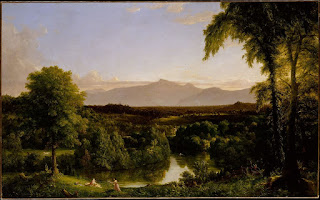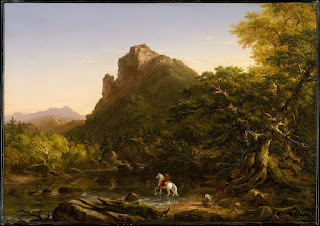The artworks of Thomas Cole display a very ornate elegance and naturalism. Many of his works feature the illusion of grandeur, vibrant colors, graceful pastels, and contrasting textures and shapes. For example, paintings like The Titan’s Goblet and The Mountain Ford depict golden sunlight, cascading mountain ranges, and glistening waters. Cole’s works are often seen as whimsical, dreamy, and captivating. The primary painting of analysis here is The Titan’s Goblet (1833), which will be compared and contrasted with five other paintings by Cole: A View near Tivoli (Morning) (1832), View from Mount Holyoke, Northampton, Massachusetts, after a Thunderstorm (1836), View from Catskill--Early Autumn (1836-37), Clouds (1838), and The Mountain Ford (1846).
Themes of mysticism, vibrance, and elegance are all evident in Cole’s The Titan’s Goblet. Moreover, The Titan’s Goblet has been analyzed to represent the passing of time. Field research by authors such as Ellwood C. Parry (1971) discusses the passage of time in The Titan’s Goblet, unveiling the correlation between Cole’s paintings and the theme of time. Each of the paintings that will be explored here present different elements of time, either through time of day, season, or other natural elements. Therefore, my aim is to present the passing of time as a primary theme in Thomas Cole’s The Titan’s Goblet.
The Titan's Goblet
Artist: Thomas Cole
Date: 1833
Medium: Oil on canvas
The Met Museum
Accession Number: 04.29.2
In The Titan’s Goblet, we see the movement of the sun as a symbol of time’s passing. Whether the sun is interpreted to be rising or setting, its movement makes evident that time is a central element of the painting. Moreover, the lake water from the goblet spilling over the sides is another key element symbolizing time’s passing. The natural elements throughout the painting, such as the greenery, the rock formations, and the colors in the sky, support the theme of time due to the fact that each of these elements would be presented differently if it had been painted to represent a different time of day or season.
Artist: Thomas Cole
Date: 1832
Medium: Oil on canvas
The Met Museum
Accession Number: 03.27
A View near Tivoli (Morning) specifically presents the morning as an element of time. As Cole makes clear in this painting, the morning fog, dew, and soft golden sunbeams that are evident here are passing things. Morning itself signals the passage of nighttime, as well as the beginning of a new day. The decaying structures on the right side of the painting symbolize the slow fading of material possessions over long periods of time. Thus, the fact that this painting takes place in the morning and features decomposing man-made structures signal a more evident, tangible passage of time.
Massachusetts, after a Thunderstorm
Artist: Thomas Cole
Date: 1836
Medium: Oil on canvas
The Met Museum
Accession Number: 08.228
The most apparent element of time in this painting is the thunderstorm’s passage. From the title, it is clear that a thunderstorm had just approached this area of land; however, at the time this painting occurred, the storm was passing on to its next location. Thus, we see not only that storms eventually subside, but also that the passage of time aids the stresses and worries of life to recede. Cole made clear that time’s passing allows both the look and feel of nature to change.
View on the Catskill--Early Autumn
Artist: Thomas Cole
Date: 1836-37
Medium: Oil on canvas
Accession Number: 95.13.3
Cole presents the season of autumn as his primary element of time in View on the Catskill--Early Autumn. Here, we see many warm, earthy rust and golden tones that represent autumn. The golden sunlight beaming across deep orange treetops signal that time has passed long enough in the year to get to autumn. Moreover, the way color and positioning of the sunlight hint toward sunset, which is another element of time’s passage that Cole uses in this painting.
Artist: Thomas Cole
Date: 1838
Medium: Oil on paper laid down on canvas
Accession Number: 2013.201
Many people associate the passage of time in nature with the movement of clouds. Thomas Cole seems to think similarly, depicting movement in Clouds. The elegant sweeping strokes and contrasts of light and dark symbolize cloud movement in this painting. The pastel pinks, deep lavenders, and dusty blues in the sky behind the clouds signal the beginning of dusk, a specific time of evening. There is a faint sunlight glow behind the clouds, which can be explained by the sun’s setting. Therefore, this painting represents the passage of time in a more nuanced way.
Artist: Thomas Cole
Date: 1846
Medium: Oil on canvas
The Met Museum
Accession Number: 15.30.63
The passage of time is presented here by Cole’s use of the traveler on the white horse, the golden leaves on treetops, and the positioning of sunlight. One of the most powerful symbols of time within this painting is the traveler. Traveling typically involves a significant amount of time, depending on methods of transportation. More specifically, traveling by horse requires a much larger sacrifice of time than other modern modes of transportation. The traveler is seen on horseback, while his horse hesitates at the sight of passing over a body of water. The hesitation exhibited by the horse means that even more his travels will take even more time, as he would have to comfort his horse before they could continue their journey. In addition, the golden leaves on trees symbolize autumn, which takes place during a specific time of year. Moreover, the deep gold sunbeams glistening on the water represent that the day is getting later, which involves more time passing.
In conclusion, each of these Thomas Cole paintings symbolizes the passage of time in very specific ways. However, each of these means of time’s passing represent that this is a consistent theme in his paintings. Therefore, these paintings support the thesis that the passing of time as a primary theme in Thomas Cole’s The Titan’s Goblet.






No comments:
Post a Comment